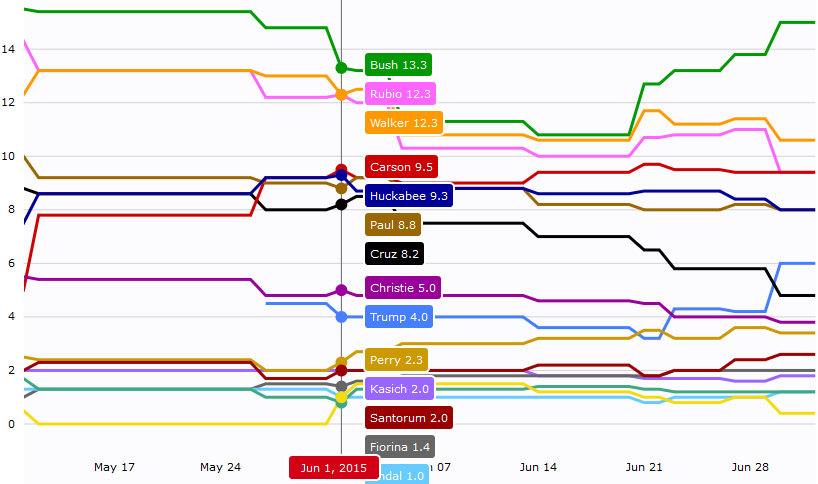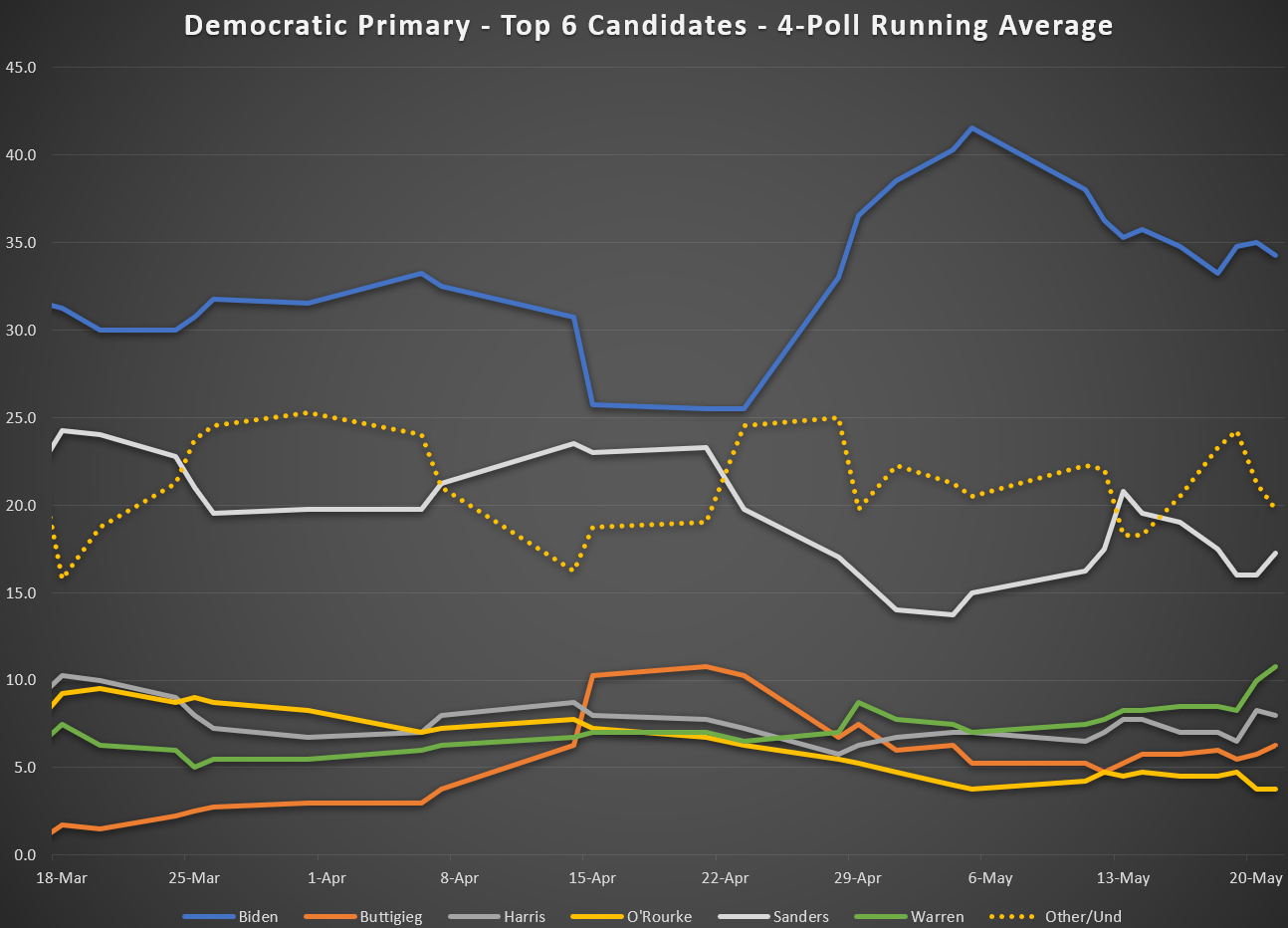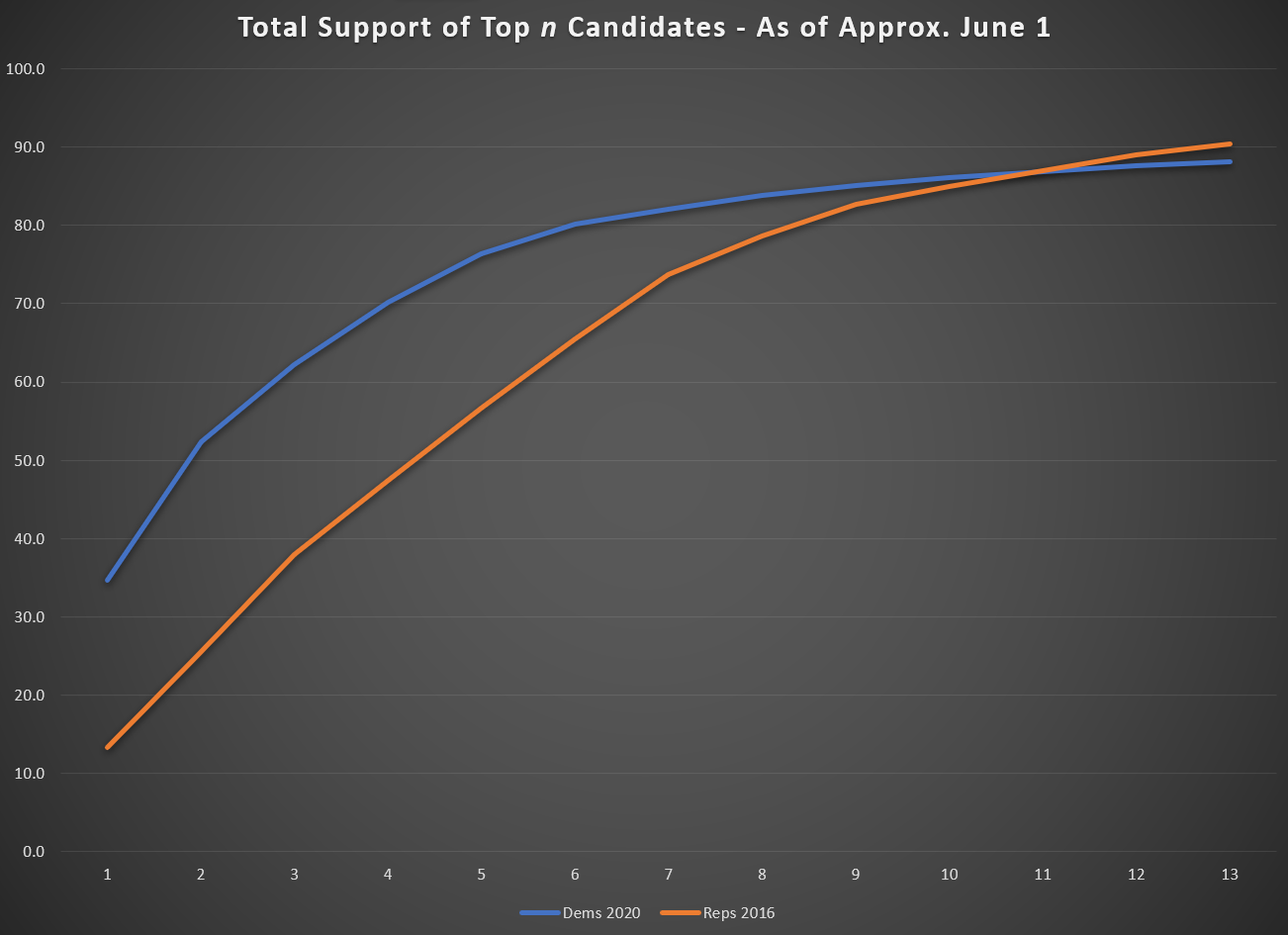Even though we’re more than 8 months out from the start of the Democratic Primary, the inevitable circus of a presidential primary is already well under way. So much so that one of the key challenges facing Democrats is whittling the Costco-sized bulk pack of 24 candidates already in the running down to a more manageable (and comprehensible) number.
The Democratic National Committee (DNC) has attempted to cull the herd a little bit by only allowing a maximum of 20 candidates to qualify for the debates, the first of which takes place in two parts on June 26th and 27th in Miami, Florida. The two qualifying standards are (a) receiving donations from 65,000 or more individual donors, or (b) getting at least 1% support on 3 polls approved by the DNC.
If more than 20 candidates meet either of these requirements, priority will be given to candidates in the following order:
- Candidates who meet both requirements. 13 candidates have done so as of now.
- Candidates with the highest polling average. 6 candidates have met the 1% minimum without meeting the donation threshold.
- If further tiebreaking is necessary, the candidates with the most unique donors will take the remaining spot(s).
Given that 19 candidates have met one or both requirements, the tiebreakers are probably going to come into play.
But despite the huge number of candidates on the debate stage, Democrats have consolidated support more quickly than Republicans did in 2016.
The fact that there are currently 19 candidates with a reasonable degree of public recognition may give the impression that there is a cavalcade of candidates neck-and-neck at around 10% support in the polls. But while the 2020 Democratic Primary and 2016 Republican Primary may be similar in terms of number of candidates-—hence why the 2016 Republican Primary is perhaps the most obvious comparison—they are night and day when it comes to the distribution of support.
The most obvious difference is the strength of the front runners. In the 2016 Republican Primary, all of the candidates were extremely weak until late in the game. No candidate ever averaged higher than 18 percent until late July 2015. Donald Trump didn’t break 35% until late January 2016, days before the Iowa caucus, and didn’t break 40% until late March, when he was already running away with the primary.
On the other hand, I can’t find evidence of a major poll in which Joe Biden didn’t exceed the 18% mark (even as far back as January 2018) that didn’t get broken by a Republican until July 2015. Meanwhile, in the 2020 Democratic race Biden went on to break 35% in late April 2019, and 40% in the first week of May. While his numbers have slipped a bit since then, he’s still holding around 35%, doing so 8 months before Trump did.
The other major difference is, well, the strength of everyone else but the front runner. Around this time in May 2015, there were five candidates in the Republican Primary that were routinely polling above 10%—Jeb Bush, Ben Carson, Mike Huckabee, Marco Rubio, and Scott Walker. In addition, Chris Christie, Ted Cruz, and Rand Paul were also regularly breaking 5%, and very occasionally 10%. That means that there were eight candidates that merited a fair amount of consideration. None of the candidates were ever very far behind the front runner.

This snapshot of the 2016 Republican Primary on June 1, 2015 makes it clear just how divided the race was. There was less than a 12 1/2 point difference between 1st place and 14th place. In mid-June, that difference shrank to less than 10 points.
Though the fact that none of them was managing to sustain support above 15% was a major hint that they were all vulnerable to being wiped out by another candidate, as ultimately happened. (There was even a time in June 2015 when Jeb Bush was averaging less than 11% as the front runner.)
But on the Democratic side, even the (consistently) second place candidate, Bernie Sanders, has only briefly once fallen below 15% support over the last 3 months. If his polling from March through May of 2019 were overlaid on top of the Republican polling from March through May 2015, Sanders would have been a comfortable front runner for most of that period of time. But on the Democratic side in the present day, he is currently being doubled up on by Biden, who is at about 34% versus Sanders’ 17%.

The scales involved in the Democratic Primary of 2020 are much different than the 2016 Republican Primary. Sanders would be leading the Republican race despite trailing Biden by quite a bit, and Biden’s support is roughly equal to the total support of the top 3 Republicans at this point in 2016.
Even Democratic candidates seemingly left in the dust are pretty lively given the circumstances. Over the last 3 months, Biden and Sanders have combined for about 48% to 55% of the vote in polling. With two candidates sucking the oxygen out of the room, it seems reasonable that the other 22 candidates would be rounding errors. But despite that, 3 candidates—Warren, Harris, and Buttigieg—have been consistently above 5%, with Warren recently creeping into the rarefied air of double digits that the majority of their competitors could only dream of.
Support for candidates after the top 2 doesn’t just sort of gradually decline into a near flatline, with 10 candidates at 3% support, despite how much more disadvantaged the second-tier candidates are. Again, consider that Bobby Jindal with his 1% support in 14th place on June 1, 2015 was only 12.3 points behind the front runner in that race, less than the 17 point difference between 1st place Biden and 2nd place Sanders. You would think that people would give up and walk away, but they aren’t. Kamala Harris’s 8-point support at 4th place isn’t that much worse than Ben Carson’s 9.5-point support, despite the fact that the top 3 in the Democratic race eat up 62% or so of voters, versus the top 3 in the Republican race only accounting for 38% of Republican voters.
The second-tier candidates do a good job of holding on to support. But after that, it does flatline hard. If you’re not in the top 6, you’re dead. Stronger Democrats are simply doing a better job of consolidating support early on than Republicans did in 2016. In that graph above, the 9th place candidate (Donald Trump) had 4 points of support on average. You only have to get down to 6th place with the Democrats to get down to a candidate with 4 points of support (O’Rourke).
An interesting way of visualizing this difference in consolidation is to look at the total support for the top 1, 2, 3, 4, etc. candidates in the two races:

Even looking past the first couple candidates, you can see that the total support for Democrats tails off quite quickly and aggressively. Despite the fact that there are 24 Democrats are currently running, versus the (“only”) 16 Republicans who had declared at this point in 2015, the top 11 candidates in each race share the same support. Or to give the inverse comparison, the bottom 5 Republicans in 2015 had the same amount of support as the bottom 13 Democratic candidates currently do—about 13%. Slightly less than the bottom third of the Republican field averaged 2.6% support, while more than the bottom half of the Democratic field is averaging 1% support. Democratic voters are very aggressively whittling down the field by essentially discarding half out of hand.
Takeaway 1: I think we’re never going to have more than a 6-way race, and that will begin to consolidate further before the year is out. Right now, the top 6 Democrats are combining for 80% of the vote share (versus the 9 Republicans it took to cross the 80% mark in 2015). My suspicion is that Democratic supporters are going to become more ruthless as time goes on. What could be considered a 6-way race right now (if we’re charitable to Buttigieg and O’Rourke) may realistically be a 5-way race in another month or two, and become a 4- or even 3-way race by the end of the year.
Maybe I’m wrong. Maybe the debates this summer will bring promising new talent to the awareness of the public, and we’ll see support fragment. But I think instead it’ll be more like water sloshing in a bathtub. Support will shift from a couple major candidates to a promising new one, hold for a bit, and then shift back. This is what I think happened with Buttigieg, where Biden dropped down to 25% just before he announced he was running and Buttigieg popped up over 10%, before both reverted to their mean.
The other option is that if the new candidate holds people’s attention after that trial period, the candidate who lost support will quickly wilt and die. This is something that I think could be happening with Sanders and Warren right now. Warren has been gaining steam, while Sanders struggled to get back to the 20% mark, which he consistently ran above for March and much of April. A weakened candidate could hit a tipping point where the rest of their supporters cut bait and quickly move to strengthen the rising counterpart. We’ll see if that plays out.
Takeaway 2 : There will likely not be a Democratic Trump shaking up the field. If there’s a last-second entry into the Democratic Primary from a fringe-but-popular candidate (I don’t know that would be. Oprah? Barack Obama’s identical twin brother?), they’re going to have a hard time amassing support. Trump could peel away a mere 20% of the support from the top-5 candidates in the Republican race and suddenly be the front runner by a few points.
But a fringe Democrat taking 20% of the support from Biden and Sanders (controlling a share of the vote roughly equal to the top 5 Republicans in 2016) would only be at 10%, while the newly weakened Biden would still be running at about 27%. Alternatively, they would have to take a majority of support from 7 or 8 candidates to be competitive with the current front runners. Neither is likely. A late entrant can’t just pick up weak supporters of a few candidates to amass decent support. They’d have to really start chewing into core supporters of top candidates to make decent headway.
Thus, I would argue that even if Biden and Sanders were severely hampered as the race progressed, or even if one of them dropped out, the outcome of the race would really boil down to the top 4 or 5 candidates. There isn’t going to be a Democratic version of Trump in 2020.
You might argue, “But with a top candidate dropping out, you’d have a diaspora of supporters going all over the place, with no one really consolidating support in the wake of that.” But, that will bring us to Part 2 of this post: How will the race change as candidates drop out?